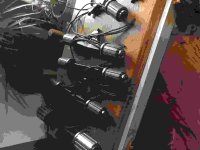Hummina Shadeeba
1 MW
Galvanic corrosion would be possible between the indium and the nickel plated steel of the motor case but the copper wouldn’t be in contact as it would of course be insulated. Supposedly nickel will cover with oxides which should be removed for best thermal transfer but that seems nitpicking.
Indium.com have had enough of my questions and only have answers related to it’s common use. The tech help person was looking up galvanic corrosion while on the phone with me and it seemed new to her. I’m still wondering how this corrosion would go between cast indium around nickel as they’re pretty close on the chart. I always here galvanic corrosion needing an electrolyte but there would be no electrolyte maybe as they’re would be no gap between them, but I think the electrolyte is more so used as a pathway between the two metals and if they’re literally touching it wouldn’t be needed.
I could remove the nickel and be left with bare mild steel or I could get another finish put on the parts in the future if needed. Maybe I should use some flux, don’t know. It’s seeming with this super soft metal thermal expansion isn’t an issue and just possibly galvanic corrosion. But solder sticks for years so I think be good
Not the cheapest stuff at maybe 50 cents a gram.
Indium.com have had enough of my questions and only have answers related to it’s common use. The tech help person was looking up galvanic corrosion while on the phone with me and it seemed new to her. I’m still wondering how this corrosion would go between cast indium around nickel as they’re pretty close on the chart. I always here galvanic corrosion needing an electrolyte but there would be no electrolyte maybe as they’re would be no gap between them, but I think the electrolyte is more so used as a pathway between the two metals and if they’re literally touching it wouldn’t be needed.
I could remove the nickel and be left with bare mild steel or I could get another finish put on the parts in the future if needed. Maybe I should use some flux, don’t know. It’s seeming with this super soft metal thermal expansion isn’t an issue and just possibly galvanic corrosion. But solder sticks for years so I think be good
Not the cheapest stuff at maybe 50 cents a gram.


